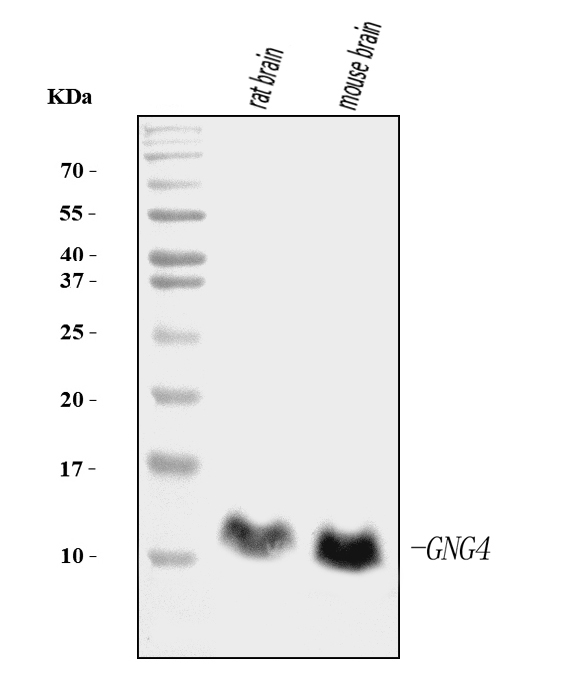Anti-GNG4 Antibody Picoband™ (monoclonal, 7B6)
- SPECIFICATION
- CITATIONS
- PROTOCOLS
- BACKGROUND

Application
| WB |
|---|---|
| Primary Accession | P50150 |
| Host | Mouse |
| Isotype | Mouse IgG1 |
| Reactivity | Rat, Mouse |
| Clonality | Monoclonal |
| Format | Lyophilized |
| Description | Anti-GNG4 Antibody Picoband™ (monoclonal, 7B6) . Tested in WB applications. This antibody reacts with Mouse, Rat. |
| Reconstitution | Adding 0.2 ml of distilled water will yield a concentration of 500 µg/ml. |
| Gene ID | 2786 |
|---|---|
| Other Names | Guanine nucleotide-binding protein G(I)/G(S)/G(O) subunit gamma-4, GNG4, GNGT4 |
| Calculated MW | 12 kDa |
| Application Details | Western blot, 0.25-0.5 µg/ml, Mouse, Rat |
| Contents | Each vial contains 4 mg Trehalose, 0.9 mg NaCl and 0.2 mg Na2HPO4. |
| Clone Names | Clone: 7B6 |
| Immunogen | E.coli-derived human GNG4 recombinant protein (Position: M1-D52). |
| Purification | Immunogen affinity purified. |
| Storage | At -20°C for one year from date of receipt. After reconstitution, at 4°C for one month. It can also be aliquotted and stored frozen at -20°C for six months. Avoid repeated freezing and thawing. |
| Name | GNG4 |
|---|---|
| Synonyms | GNGT4 |
| Function | Guanine nucleotide-binding proteins (G proteins) are involved as a modulator or transducer in various transmembrane signaling systems. The beta and gamma chains are required for the GTPase activity, for replacement of GDP by GTP, and for G protein-effector interaction. |
| Cellular Location | Cell membrane; Lipid-anchor; Cytoplasmic side |
| Tissue Location | Brain, kidney, pancreas, skeletal muscle and faintly in cardiac muscle |

Thousands of laboratories across the world have published research that depended on the performance of antibodies from Abcepta to advance their research. Check out links to articles that cite our products in major peer-reviewed journals, organized by research category.
info@abcepta.com, and receive a free "I Love Antibodies" mug.
Provided below are standard protocols that you may find useful for product applications.
Background
Guanine nucleotide-binding protein G(I)/G(S)/G(O) subunit gamma-4 is a protein that in humans is encoded by the GNG4 gene. This gene encodes the gamma subunit of the heterotrimeric G-proteins that are comprised of alpha, beta and gamma subunits. Upon activation by G protein-coupled receptors, the beta-gamma heterodimer dissociates from the alpha subunit to activate downstream signaling events. Alternate splicing results in multiple transcript variants.
If you have used an Abcepta product and would like to share how it has performed, please click on the "Submit Review" button and provide the requested information. Our staff will examine and post your review and contact you if needed.
If you have any additional inquiries please email technical services at tech@abcepta.com.













 Foundational characteristics of cancer include proliferation, angiogenesis, migration, evasion of apoptosis, and cellular immortality. Find key markers for these cellular processes and antibodies to detect them.
Foundational characteristics of cancer include proliferation, angiogenesis, migration, evasion of apoptosis, and cellular immortality. Find key markers for these cellular processes and antibodies to detect them. The SUMOplot™ Analysis Program predicts and scores sumoylation sites in your protein. SUMOylation is a post-translational modification involved in various cellular processes, such as nuclear-cytosolic transport, transcriptional regulation, apoptosis, protein stability, response to stress, and progression through the cell cycle.
The SUMOplot™ Analysis Program predicts and scores sumoylation sites in your protein. SUMOylation is a post-translational modification involved in various cellular processes, such as nuclear-cytosolic transport, transcriptional regulation, apoptosis, protein stability, response to stress, and progression through the cell cycle. The Autophagy Receptor Motif Plotter predicts and scores autophagy receptor binding sites in your protein. Identifying proteins connected to this pathway is critical to understanding the role of autophagy in physiological as well as pathological processes such as development, differentiation, neurodegenerative diseases, stress, infection, and cancer.
The Autophagy Receptor Motif Plotter predicts and scores autophagy receptor binding sites in your protein. Identifying proteins connected to this pathway is critical to understanding the role of autophagy in physiological as well as pathological processes such as development, differentiation, neurodegenerative diseases, stress, infection, and cancer.


